March 27: (Madison/Pittsburgh KOA)
We are stopped about 2 hours from State College mid-way between Pittsburg and Fallingwater. The KOA is on a hillside, with a pond at the bottom.
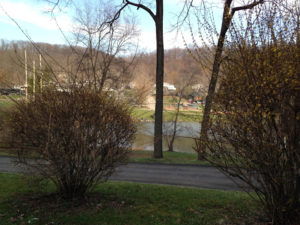 We decided we needed a couple of days for R&R and work. So, there is not too much to report for the first couple of days. I did multiple walks around the campground with the dog, working on my birdwatching skills. The campground is overrun with sparrows and robins, so we are seeing lots of not very interesting birds. However, I decided to join eBird and send in my lists. At least I am pretty confident about what I am seeing (e.g. 27 robins in 20 minutes).
We decided we needed a couple of days for R&R and work. So, there is not too much to report for the first couple of days. I did multiple walks around the campground with the dog, working on my birdwatching skills. The campground is overrun with sparrows and robins, so we are seeing lots of not very interesting birds. However, I decided to join eBird and send in my lists. At least I am pretty confident about what I am seeing (e.g. 27 robins in 20 minutes).
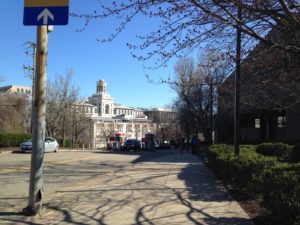
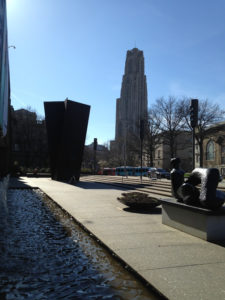
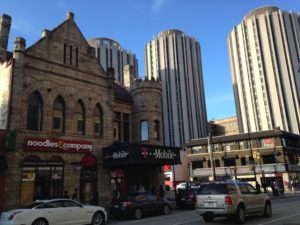 We decided to spend Wednesday in Pittsburgh. Although we were regular visitors when Jonathan was studying at CMU, we never saw the Carnegie Museums of Art and Natural Science, even though they are at the edge of campus. We made up for it this time, although we could not see everything in one afternoon. The photos are CMU as seen from in front of the museum, U. Pittsburgh as seen from the museum, and an old post office on Forbes Street, just down from UPitt and looking towards it.
We decided to spend Wednesday in Pittsburgh. Although we were regular visitors when Jonathan was studying at CMU, we never saw the Carnegie Museums of Art and Natural Science, even though they are at the edge of campus. We made up for it this time, although we could not see everything in one afternoon. The photos are CMU as seen from in front of the museum, U. Pittsburgh as seen from the museum, and an old post office on Forbes Street, just down from UPitt and looking towards it.
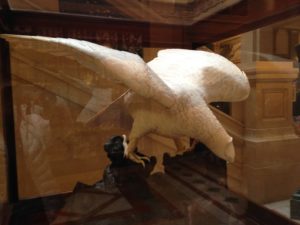 We started in the bird hall, which of course was appropriate given our new interest. It is small but interesting – however, not too useful for new birders.
We started in the bird hall, which of course was appropriate given our new interest. It is small but interesting – however, not too useful for new birders.
We then split up, although in the end we both saw the same exhibits. I headed to the mineralogy exhibit, which is one of my passions. The hall has a number of nice specimens. However, what is really different is that they use mirrored walls to get a kaleidoscope effect. As a result, when you walk into the main part of the display, it is quite dizzying. There are a lot of specimens, and I examined every one.
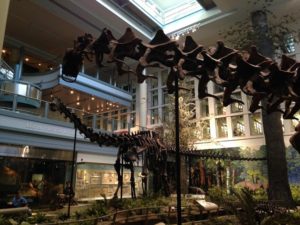 From there I went to the dinosaur exhibit, which I think is one of their specialities. It is certainly a very interesting exhibit, including some history of the excavations, mounted fossils of some huge beasts,
From there I went to the dinosaur exhibit, which I think is one of their specialities. It is certainly a very interesting exhibit, including some history of the excavations, mounted fossils of some huge beasts,
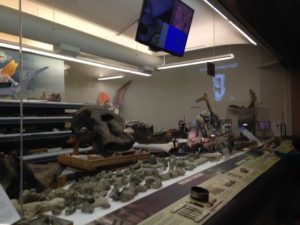
and a curator workshop where you can see the paleontologists preparing specimens.
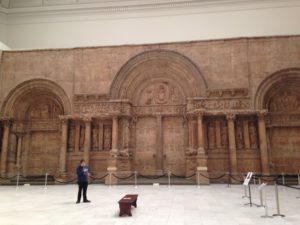 An interesting part of the museum is the architecture hall, which has full-size plaster reconstructions of some of the churches, fountains etc of Europe. It is quite amazing to see these works, which apparently were created as teaching pieces for students in the days when travel to Europe would be too expensive for most.
An interesting part of the museum is the architecture hall, which has full-size plaster reconstructions of some of the churches, fountains etc of Europe. It is quite amazing to see these works, which apparently were created as teaching pieces for students in the days when travel to Europe would be too expensive for most.
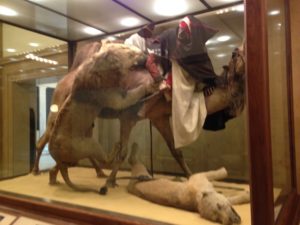 Just outside the architecture hall is this interesting diorama which dates back to the 1800’s. Among the interesting features of the work: the lions that were used in the display are from a species that is now extinct. As well, the human figure was built over a real skull!
Just outside the architecture hall is this interesting diorama which dates back to the 1800’s. Among the interesting features of the work: the lions that were used in the display are from a species that is now extinct. As well, the human figure was built over a real skull!
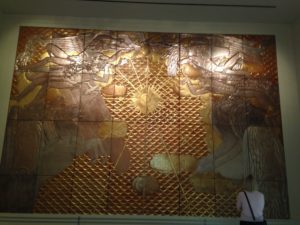
I also spent some time in the art gallery. There was a lot to see and not much time, so I focused on pieces I liked, rather than trying to see everything or focus on an artist or style.
At Chuck’s advice, I spent the last few minutes at a fashion exhibit (which I might otherwise have passed up). I would have to say that this was about using the model as a display for pieces of art, rather than about clothing. It was all very interesting stuff, much of it made on 3D printers. But I doubt it is actually wearable even on the runway.
We had lunch on S. Craig Street which we knew well from Jonathan’s CMU days, and ate dinner at Schenely Park, where Rumple could sit at our feet. Sadly, the Conflict Cafe closed early so we could not eat there, but our waitress at the Schenely Park Cafe was one of the co-owners and told us how they had got the idea. She and a friend had discussed opening an ethnic food cafe, and all the cuisines they came up with were in conflict zones. So they decided to open a cafe that would serve food from different conflict zones and encourage their clientele to discuss the issues involved. They were serving Iroquois food when were were there (but only until 6 p.m. sadly- we got their at 7) and they are switching to Palestinian soon. Anyways, we probably got a better idea of the concept from our waitress than we might have had we actually eaten at the Conflict Cafe.
On Thursday we headed out to view 2 homes designed by Frank Lloyd Wright. We took the “in-depth” tours, which gave us a bit more background and time.
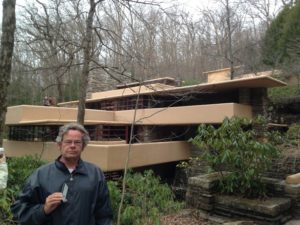 Fallingwater is Wright’s most famous private home. It was commissioned by the Kaufmann family, who owned a chain of department stores that only recently closed. They had a property in the mountains south of Pittsburgh that they used for outdoor R&R for themselves and their employees.
Fallingwater is Wright’s most famous private home. It was commissioned by the Kaufmann family, who owned a chain of department stores that only recently closed. They had a property in the mountains south of Pittsburgh that they used for outdoor R&R for themselves and their employees.
Pittsburgh was filthy from mining and burning coal at that time (the 1930s) – so much so that businessmen brought 2 white shirts to work so that after lunch they could change out of the morning shirt, that would already be grey!
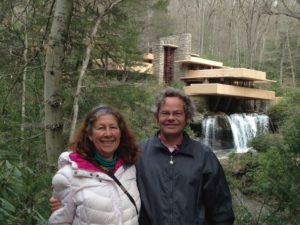 The Kaufmann’s son was interested in architecture and met Wright. When his parents decided to build a weekend cottage on their mountain property, he convinced them to hire Wright for the design. They had envisioned putting the cottage on a point overlooking a waterfall on their property. This photo is taken from the point, with the house and waterfall in the background.
The Kaufmann’s son was interested in architecture and met Wright. When his parents decided to build a weekend cottage on their mountain property, he convinced them to hire Wright for the design. They had envisioned putting the cottage on a point overlooking a waterfall on their property. This photo is taken from the point, with the house and waterfall in the background.
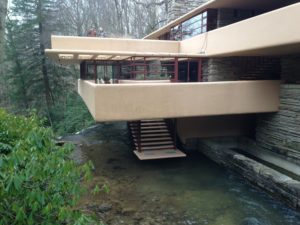 Wright decided instead to cantilever the house over the falls, so that the house, the rocks and the falls were an organic whole. The entire project was supposed to cost $30K, but there were a few overruns, and it ended up being $150K. Amazingly, the Kaufmanns continued to be friends with Wright.
Wright decided instead to cantilever the house over the falls, so that the house, the rocks and the falls were an organic whole. The entire project was supposed to cost $30K, but there were a few overruns, and it ended up being $150K. Amazingly, the Kaufmanns continued to be friends with Wright.
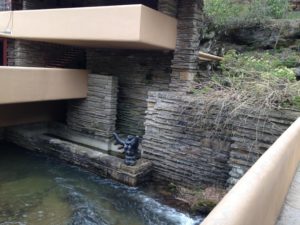 The house is designed to blur the distinction between inside and outside. Some of the walls are built right into the rocks and it must have been quite picky work to cut beams and glass to fit along the irregular contours. As well, on the creek side most of the corners of the structure are made up of windows.
The house is designed to blur the distinction between inside and outside. Some of the walls are built right into the rocks and it must have been quite picky work to cut beams and glass to fit along the irregular contours. As well, on the creek side most of the corners of the structure are made up of windows.
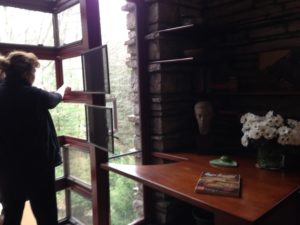
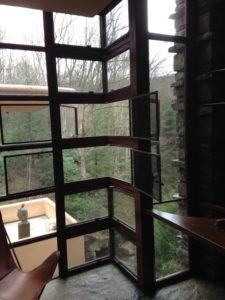 (This was a new idea at the time.) In one room, the windows have frames, but the frames then can be opened and the corner itself disappears. In this picture you can see the guide showing how the window can be opened leaving the frame (where her hand is) but the frame can also be opened (below her hand) to remove the entire corner of the room. As well, you can see the cut-out in the desk that was needed to make it possible to open the window.
(This was a new idea at the time.) In one room, the windows have frames, but the frames then can be opened and the corner itself disappears. In this picture you can see the guide showing how the window can be opened leaving the frame (where her hand is) but the frame can also be opened (below her hand) to remove the entire corner of the room. As well, you can see the cut-out in the desk that was needed to make it possible to open the window.
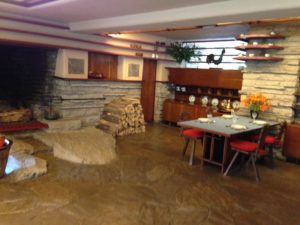 The house is entirely oriented towards the creek, with almost windowless walls (for example the dining room) against the rocks on the other side.
The house is entirely oriented towards the creek, with almost windowless walls (for example the dining room) against the rocks on the other side. 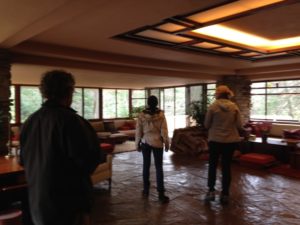 The decks all cantilever over the creek. The Kaufmanns did not trust Wright’s computations on how to construct the cantilevers, and hired an engineer to check the construction. As a result, much stronger steel beams were used. However, the engineer was not conservative enough, and significant cracks soon developed. To save the structure, the decks had to be levered up half an inch and reinforced.
The decks all cantilever over the creek. The Kaufmanns did not trust Wright’s computations on how to construct the cantilevers, and hired an engineer to check the construction. As a result, much stronger steel beams were used. However, the engineer was not conservative enough, and significant cracks soon developed. To save the structure, the decks had to be levered up half an inch and reinforced.
Wright used an open floor plan in the main social area of the house (again a novel idea at the time). He used an idea that the guide called compression – the areas that he wanted people to move through quickly are very tight and dark, but look into the open and light part of the space where he expected people to linger.
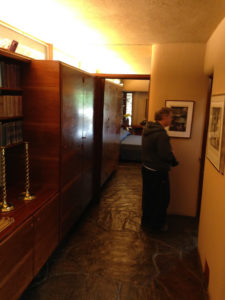 Another device was to continue the same stonework, plasterwork or woodwork inside and outside the house, so that e.g. walking from the living room to a deck, only the door frame gives a clue that you are going outside. In the guest house he did something even more clever – a cabinet on one side of a door has handles on the left and on the other side has handles on the right, giving the illusion that the door frame is a mirror, shown here.
Another device was to continue the same stonework, plasterwork or woodwork inside and outside the house, so that e.g. walking from the living room to a deck, only the door frame gives a clue that you are going outside. In the guest house he did something even more clever – a cabinet on one side of a door has handles on the left and on the other side has handles on the right, giving the illusion that the door frame is a mirror, shown here.
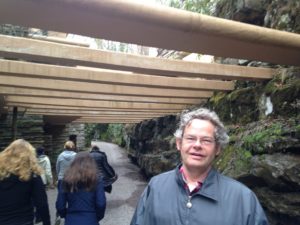 The guesthouse is connected to the main house by a corridor over the outside walkway, and is actually a separate structure up higher on the rocks. However, it is positioned so that when approaching the house you appear to be going to a much taller single building.
The guesthouse is connected to the main house by a corridor over the outside walkway, and is actually a separate structure up higher on the rocks. However, it is positioned so that when approaching the house you appear to be going to a much taller single building.
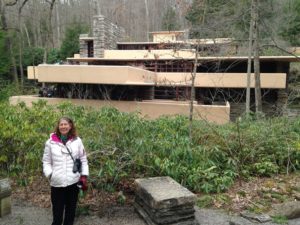 Although it appears from this view that I am standing in front of a 5 storey house, the main house is only the first 3 levels. The other 2 levels are a completely separate house.
Although it appears from this view that I am standing in front of a 5 storey house, the main house is only the first 3 levels. The other 2 levels are a completely separate house.
Wright designed and built in much of the furniture in the house. All the wood grain is horizontal on the furniture and vertical on the doors, giving an illusion of length and height respectively. In one amusing anecdote, the Kaufmanns disputed the size of the desks that were built into some of the rooms. Wright pointed out that if they would be any larger, they would interfere with the windows. However, Mr. Kaufmann said that he could not write such a large cheque on such a small desk, thus winning the day. Wright built a well into each desk so that the windows could be opened as you can see above.
Wright hated attics, basements and garages. However, he agreed to put a basement into the house for the furnace. The vehicles were stored in a carport, with one open side, because he pointed out that unlike horses the cars would not escape.
Chuck was quite taken by the fact that despite the cost overruns on the house, the Kaufmann’s fully furnished the servants’ quarters with the same level of trappings as the family and guest quarters.
The design might have been brilliant, but the engineering was flawed. The roof started to leak immediately. When the Kaufmanns called to complain, Wright reputedl suggested that they put buckets under the leaks.
The house was designed to become part of the waterfall when the rain is sufficiently heavy. Ironically, we had changed our plans to visit the house on Tuesday because the weather forecast (which was accurate) was for heavy rain. Our guide claimed that seeing the house in a rainfall or when the snow is melting is really the best.
From Fallingwater, we went through Ohiopyle State Park to reach Kentuck Knob, a privately owned Wright house that is quite different from Fallingwater. Kentuck Knob was originally commissioned by the Hagans, successful dairy farmers who were friends with the Kaufmanns. Wright built it without ever visiting the site, even though it was also supposed to be an organic whole with the hillside (Knob) on which it sits. It was a larger version of a type of house which Wright had designed for the “average American” called the USonian style. This house was also supposed to cost $30K and came in only slightly over budget.
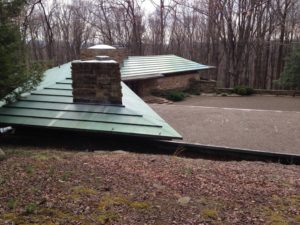 Since it is a private house and still used by the owners, no photos are allowed inside the house. The house is built on a hexagonal design, with many hexagonal features and features made up from equilaterial triangles. The house and carport take up 4 of the 6 sides of the hexagon. This picture from above shows the 3 sides of the house and the carport, which open onto a grand entrance. Unlike Fallingwater, which has a private hidden tiny entrance, the entrance to Kentuck Knob opens expansively into the courtyard making up the interior of the hexagon.
Since it is a private house and still used by the owners, no photos are allowed inside the house. The house is built on a hexagonal design, with many hexagonal features and features made up from equilaterial triangles. The house and carport take up 4 of the 6 sides of the hexagon. This picture from above shows the 3 sides of the house and the carport, which open onto a grand entrance. Unlike Fallingwater, which has a private hidden tiny entrance, the entrance to Kentuck Knob opens expansively into the courtyard making up the interior of the hexagon.
The skylights are hexagons and the openings for the ceiling lights are triangles. As well, as you can see in the photo, the chimney is an equilateral triangle. A few features are rhombuses, made up from 2 equilateral triangles.
A wrap-around porch was designed with skylights that admitted light to the porch in the morning and directed light into the living room later in the day. (The builders told Wright to remove the glass of the skylights to avoid the heavy weight of snow on the porch roof.)
As in Fallingwater, the house was designed to obscure the boundaries between inside and outside. In fact, one skylight is half over the porch and half over the indoor dining area. The living room and dining room open onto the porch. The hexagonal kitchen is at the center of the house.
The kitchen is an interesting collaboration between the Hagans and Wright. Apparently he was not much interested in the functionality of the kitchens – since he hated basements he generally put the heating, water, electricity etc in the kitchen, leaving little work room. However, Mrs. Hagan loved to cook and they did not have servants. They convinced Wright to include a basement for their wine cellar (apparently sufficiently non-plebian for his tastes) and then put the utilities down there too, along with a place to store supplies. As dairy farmers, they were used to sterile workspaces with stainless steel counters and designed a one-piece counter and sink. We loved it – easy to clean and virtually spillproof.
As well, at the time Westinghouse was selling a fold-away stove top. All of the burners plug in individually and can be folded up against the wall. Alternatively, the burner could be unplugged and used elsewhere – e.g. as a heating element at the kitchen table. We really want this set-up for the RV, as it would more than triple our working space, but unfortunately Westinghouse was not able to sell many of the units and stopped producing them.
The house has a single corridor – modern overweight folks need to go another route. The corridor leads to a large and beautiful bedroom. Luckily all the furniture is built in, because it would be hard to get even a folding chair through the corridor.
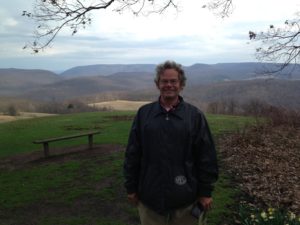 Like Fallingwater, the house is built into the hill. However, all the windows are placed so that they are at eye level when you are using the appropriate furniture (i.e. the chairs or the bed) and so you do not notice that some parts of the house are actually buried. On the other hand, the living room, dining room and porch are at the top of the Knob and overlook the garden. (You have to walk to the edge of the garden to overlook the mountains.)
Like Fallingwater, the house is built into the hill. However, all the windows are placed so that they are at eye level when you are using the appropriate furniture (i.e. the chairs or the bed) and so you do not notice that some parts of the house are actually buried. On the other hand, the living room, dining room and porch are at the top of the Knob and overlook the garden. (You have to walk to the edge of the garden to overlook the mountains.)
Mrs. Hagan also liked to draw, and a studio was added to the carport so she could paint without the odor of her oil paints reaching the house. However, the studio has absolutely no light and was apparently only used to store the supplies and finished canvasses.
The Hagans invited Wright to their open house when they first moved in. However, he declined their invitation. When they realized that he was unlikely to ever visit, they made a few modifications to make the house more liveable. Apparently he did visit the site after the house was completed, but saw only the outside. When he saw what a wonderful job the builders had done in integrating the house into the site, he declared himself satisfied.
The Hagans sold the house to the Palumbos, a British couple who are very interested in the arts and architecture. The Palumbos lived in the house part of the year for a while, but succumbed to frequent requests for house tours and now live nearby. Mrs. Palumbo was working the gift shop when we arrived.
One interesting feature of the house now is the Palumbo art collection. They have a sculpture garden (which is mostly not to my taste) and many paintings inside which I do like. As well, they collect native American pots, fossils, Frank Lloyd Wright furniture (especially pieces with a hexagonal theme) and a few other things that made the house even more fun to visit.
When I booked the Kentuck Knob tour, I wondered if we really needed to see two Wright houses, especially on the same day. The answer is: yes. The houses are very different in design and feel, with the main commonality being the integration with the landscape. Seeing them together really illustrated the genius of the man.
Incidentally, we were curious about why a house in Pennsylvania was called Kentuck Knob. A “knob” is a rounded hill. The story is that the original owner of the land was on his way to Kentucky but when he got to the top of the knob and saw the view he decided to settle right there.
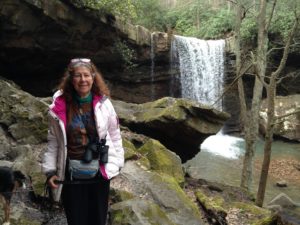 Between Fallingwater and Kentuck Knob is Ohiopyle State Park, which is well known as a white-water rafting destination on theYoughiogheny River. On the way to Kentuck Knob, we stopped at Cucumber Falls which is a pretty waterfall on a side branch of the river. On the way back, we stopped at the main rafting destination, which is below Ohiopyle Falls.
Between Fallingwater and Kentuck Knob is Ohiopyle State Park, which is well known as a white-water rafting destination on theYoughiogheny River. On the way to Kentuck Knob, we stopped at Cucumber Falls which is a pretty waterfall on a side branch of the river. On the way back, we stopped at the main rafting destination, which is below Ohiopyle Falls.
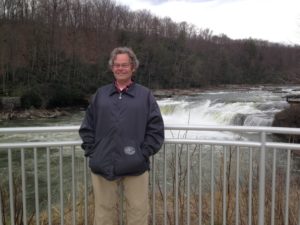 Ohiopyle Falls is only about 4 feet high, but there is a lot of water in the spring. Apparently it is “a thing” to raft or kayak over these falls but it is very dangerous. The current pulls the water (and your boat if you don’t know what you are doing) beneath the boulders and it is easy to get pinned. Beneath the falls, most of us would still need a skilled rafting guide to do the trip safely, but it is much more reasonable.
Ohiopyle Falls is only about 4 feet high, but there is a lot of water in the spring. Apparently it is “a thing” to raft or kayak over these falls but it is very dangerous. The current pulls the water (and your boat if you don’t know what you are doing) beneath the boulders and it is easy to get pinned. Beneath the falls, most of us would still need a skilled rafting guide to do the trip safely, but it is much more reasonable.
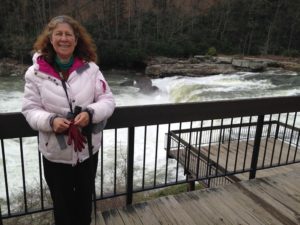 As is often the case, someone came to meet the dog and we ended up having a nice chat. Paul and Sue have had some RV adventures of their own to share and we enjoyed our time together. And, as usual, we forgot to get a photo with them.
As is often the case, someone came to meet the dog and we ended up having a nice chat. Paul and Sue have had some RV adventures of their own to share and we enjoyed our time together. And, as usual, we forgot to get a photo with them.
On to State College!
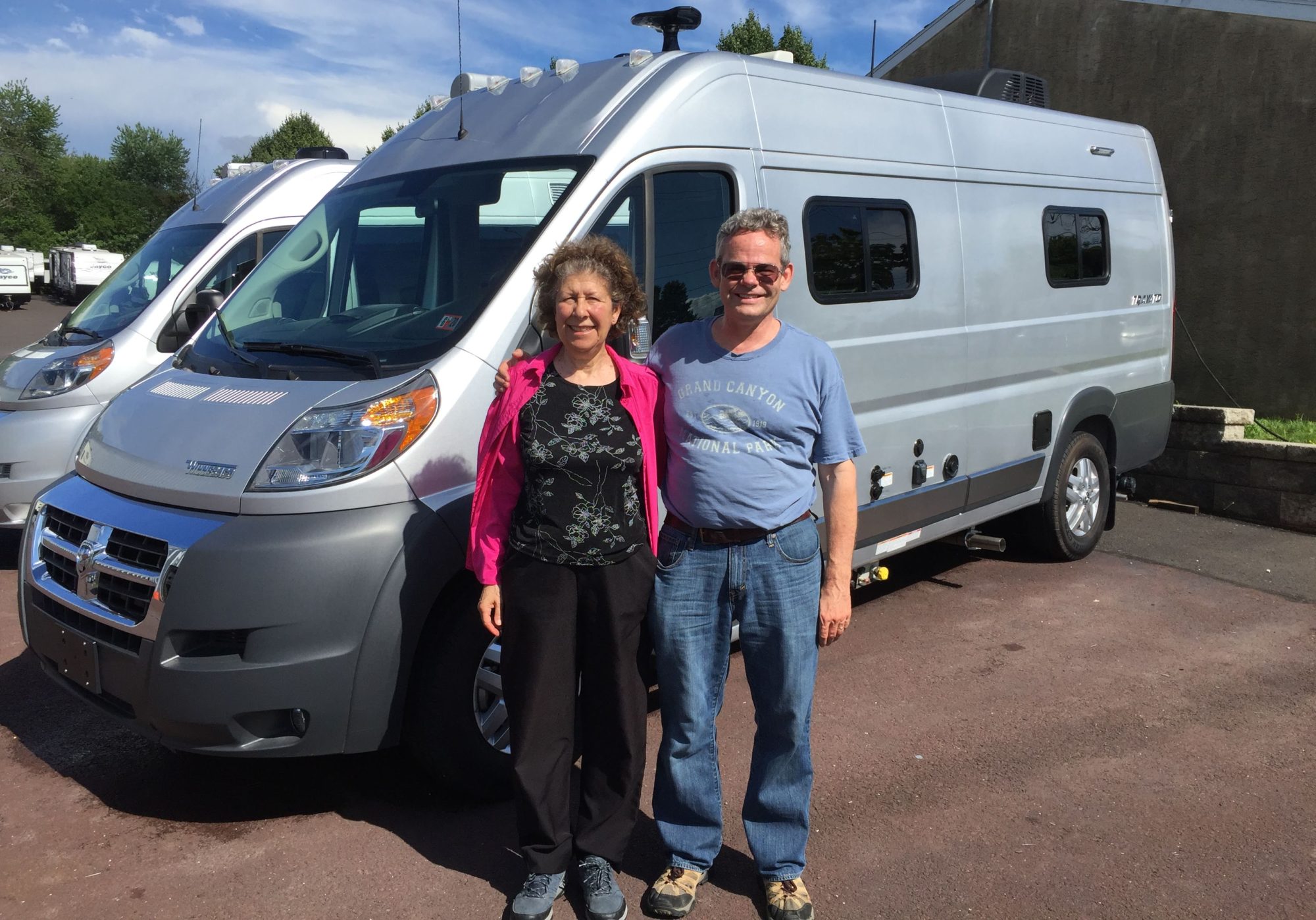
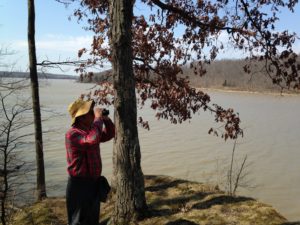 Not surprisingly, the campground is very empty with only a few other campers. It has filled slightly as the weekend arrived, mostly with campers from Dayton and Columbus, which are nearby. The weather is great, and the bugs are not biting.
Not surprisingly, the campground is very empty with only a few other campers. It has filled slightly as the weekend arrived, mostly with campers from Dayton and Columbus, which are nearby. The weather is great, and the bugs are not biting.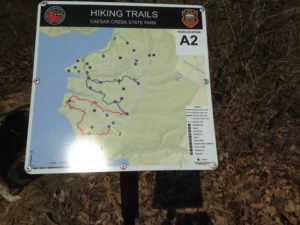 The park has a number of hiking trails, the most accessible of which is a series of loops connecting the 6 campgrounds with the lake. We walked all of them, while looking for birds. Most of the shoreline is a cliff down to the lake. However, with a strong wind whipping up the water from the bottom, the lake looks brown and dingy – not really that scenic. With few people in the park, Rumple can enjoy some off-leash time, which make the walk more pleasant for all of us.
The park has a number of hiking trails, the most accessible of which is a series of loops connecting the 6 campgrounds with the lake. We walked all of them, while looking for birds. Most of the shoreline is a cliff down to the lake. However, with a strong wind whipping up the water from the bottom, the lake looks brown and dingy – not really that scenic. With few people in the park, Rumple can enjoy some off-leash time, which make the walk more pleasant for all of us.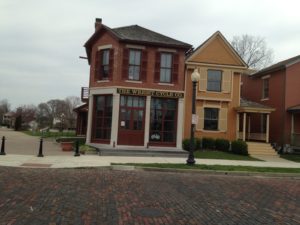 The museum starts in the Wright Brother bicycle shop. We did not realize that the Wright Brothers started as printers, and later got into bicycle sales and repairs. Most of their income came from sales of bicycles made by others. However, they did build custom bicycles.
The museum starts in the Wright Brother bicycle shop. We did not realize that the Wright Brothers started as printers, and later got into bicycle sales and repairs. Most of their income came from sales of bicycles made by others. However, they did build custom bicycles.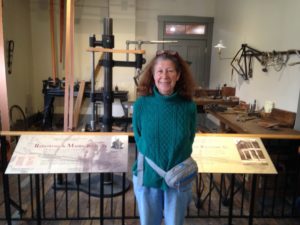 Our brother-in-law Richard Sachs builds custom bicycles and we were impressed at how similar the old workshop was to Richie’s modern shop. By the time they started building bicycles, the original “penny-farthing” bicycle with the tiny back wheel and huge front wheel was being replaced by the “safety bicycle” which looks like a modern bicycle and has a gear system.
Our brother-in-law Richard Sachs builds custom bicycles and we were impressed at how similar the old workshop was to Richie’s modern shop. By the time they started building bicycles, the original “penny-farthing” bicycle with the tiny back wheel and huge front wheel was being replaced by the “safety bicycle” which looks like a modern bicycle and has a gear system.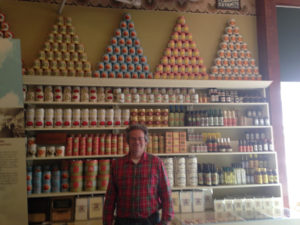 The museum also had an old general store of the era.
The museum also had an old general store of the era.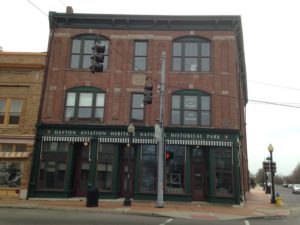 were using, and how the series of prototypes led to more designs that were more readily controlled. As well, the role of their mechanic, Charles Taylor, in developing a light weight engine was emphasized. However, there was no mention of Mr. Pratt, who claimed to have developed the wind tunnel for which the Wrights took credit. (Here are 2 articles on this – the first is by Chuck’s father: http://www.456fis.org/GEORGE%20_A._SPRATT.htm http://truthinaviationhistory.blogspot.com/2014/07/dr-george-spratt-letter-and-lost-friend.html). The museum also went through some of the Wright family history.
were using, and how the series of prototypes led to more designs that were more readily controlled. As well, the role of their mechanic, Charles Taylor, in developing a light weight engine was emphasized. However, there was no mention of Mr. Pratt, who claimed to have developed the wind tunnel for which the Wrights took credit. (Here are 2 articles on this – the first is by Chuck’s father: http://www.456fis.org/GEORGE%20_A._SPRATT.htm http://truthinaviationhistory.blogspot.com/2014/07/dr-george-spratt-letter-and-lost-friend.html). The museum also went through some of the Wright family history.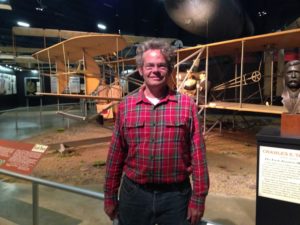 The first hangar continued the story of the Wright brothers and their competitors, through the development of the airplane industry as part of the war effort. (Remember this is a museum of the air force, not the airplane.) The first deployment of airplanes was for surveillance. It was not until later in the war that the planes were used to drop bombs and for aerial warfare.
The first hangar continued the story of the Wright brothers and their competitors, through the development of the airplane industry as part of the war effort. (Remember this is a museum of the air force, not the airplane.) The first deployment of airplanes was for surveillance. It was not until later in the war that the planes were used to drop bombs and for aerial warfare.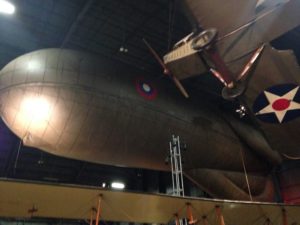 Like other aviation museums I have visited, this museum had a nice collection of vintage airplanes. There were also a couple of very unique exhibits. The museum had a WWI dirigible hanging from the ceiling. To give you and idea of the scale of the museum – it is “tucked” into a small corner. There was also a drone — the Kettering Aerial Torpedo “Bug” which essentially is a bomb with wings (and no pilot). As always in these exhibits, I cannot help but think that if the money and ingenuity that we expand on killing one another were instead spent on improving human life, we would be living in paradise.
Like other aviation museums I have visited, this museum had a nice collection of vintage airplanes. There were also a couple of very unique exhibits. The museum had a WWI dirigible hanging from the ceiling. To give you and idea of the scale of the museum – it is “tucked” into a small corner. There was also a drone — the Kettering Aerial Torpedo “Bug” which essentially is a bomb with wings (and no pilot). As always in these exhibits, I cannot help but think that if the money and ingenuity that we expand on killing one another were instead spent on improving human life, we would be living in paradise.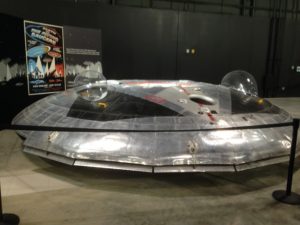 Chuck headed out to the last hangar, which had presidential airplanes and modern aircraft.
Chuck headed out to the last hangar, which had presidential airplanes and modern aircraft.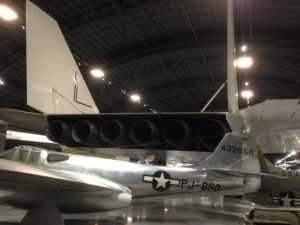 I don’t remember the name of this plane in the next picture, but the 6 rear engine exhausts looked so cool that I had to get a picture! It would be awesome to see the after burners lit on this plane.
I don’t remember the name of this plane in the next picture, but the 6 rear engine exhausts looked so cool that I had to get a picture! It would be awesome to see the after burners lit on this plane.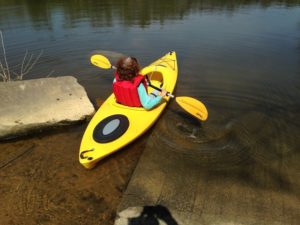 March 21st was a beautiful day. We spent half a day working and then took the hiking trail down to the lake. It was a nice, although short, hike that led to a small dam and then back to the campground by road. After that, we headed out to kayak on the lake – or more properly on the short piece of the Laurel River between the launch ramp and the trail from the campground. (We drove to the launch ramp, as the campground trail is very steep.)
March 21st was a beautiful day. We spent half a day working and then took the hiking trail down to the lake. It was a nice, although short, hike that led to a small dam and then back to the campground by road. After that, we headed out to kayak on the lake – or more properly on the short piece of the Laurel River between the launch ramp and the trail from the campground. (We drove to the launch ramp, as the campground trail is very steep.)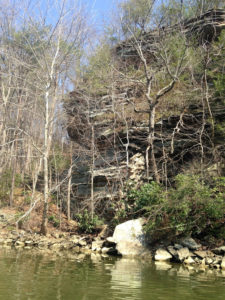
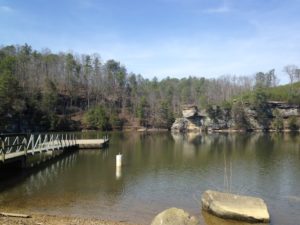
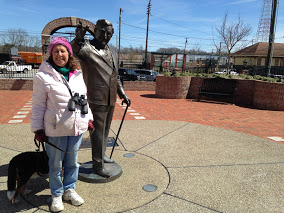 The town of Corbin used to be squarely on the main north-south route of the east. Its main claim to fame these days is that it is the original home of the Harland Sanders Restaurant. Mr. Sanders is better known these days as Colonel Sanders, and it was in Corbin that he developed his famous cooking method and coating. Appropriately we followed a truck loaded with crates of live chickens on our way into town. (It did not look like a comfortable ride for the chickens.)
The town of Corbin used to be squarely on the main north-south route of the east. Its main claim to fame these days is that it is the original home of the Harland Sanders Restaurant. Mr. Sanders is better known these days as Colonel Sanders, and it was in Corbin that he developed his famous cooking method and coating. Appropriately we followed a truck loaded with crates of live chickens on our way into town. (It did not look like a comfortable ride for the chickens.)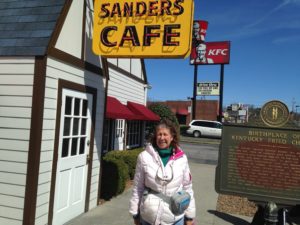 Colonel Sanders settled in Corbin after quite a varied set of careers and purchased a gas station. Since Corbin was a popular stopping place for north eastern US and Canadian tourists en route to Florida, the gas station did well.
Colonel Sanders settled in Corbin after quite a varied set of careers and purchased a gas station. Since Corbin was a popular stopping place for north eastern US and Canadian tourists en route to Florida, the gas station did well.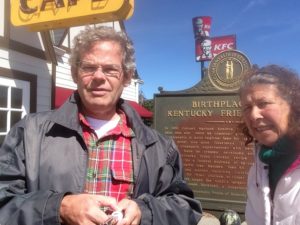 However, when the depression cut into the tourist traffic, Sanders decided to add a restaurant. He primarily made his money from the breakfast menu, but he also perfected a fast way to deep fry chicken under pressure (and hence may have started the fast food industry) as well as experimenting with coatings.
However, when the depression cut into the tourist traffic, Sanders decided to add a restaurant. He primarily made his money from the breakfast menu, but he also perfected a fast way to deep fry chicken under pressure (and hence may have started the fast food industry) as well as experimenting with coatings.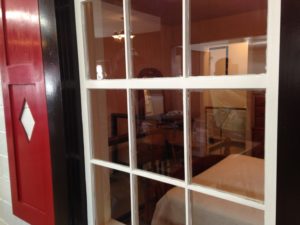 After a fire, he added a motel to the mix. Sanders was something of a marketing genius. He noticed that the women of the family tended to make decisions about where to stop and where to stay.
After a fire, he added a motel to the mix. Sanders was something of a marketing genius. He noticed that the women of the family tended to make decisions about where to stop and where to stay.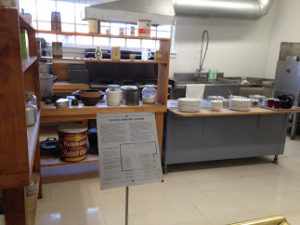 He painted all the surfaces white so that he (and his audience) could readily inspect for cleanliness. And most innovative – he put a full-sized motel room right in the restaurant (above) and positioned the women’s restroom so that the women passed through the room to get to the toilet – thus effectively advertising the rooms and their amenities.
He painted all the surfaces white so that he (and his audience) could readily inspect for cleanliness. And most innovative – he put a full-sized motel room right in the restaurant (above) and positioned the women’s restroom so that the women passed through the room to get to the toilet – thus effectively advertising the rooms and their amenities.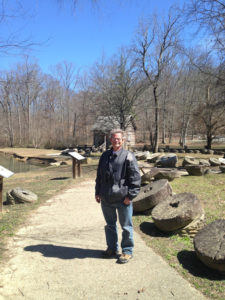 After our KFC lunch, we headed out to a state park for the Mountain Life Museum, which unfortunately was closed. However, nearby is a small historic mill, and a huge outdoor display of old millstones. Of course one sees these millstones all over the US, but it was quite fascinating to learn a bit about the different designs, and how these enormous and heavy chunks of rock were moved around, even from as far as Germany, as only certain types of stone are suitable to making millstones.
After our KFC lunch, we headed out to a state park for the Mountain Life Museum, which unfortunately was closed. However, nearby is a small historic mill, and a huge outdoor display of old millstones. Of course one sees these millstones all over the US, but it was quite fascinating to learn a bit about the different designs, and how these enormous and heavy chunks of rock were moved around, even from as far as Germany, as only certain types of stone are suitable to making millstones.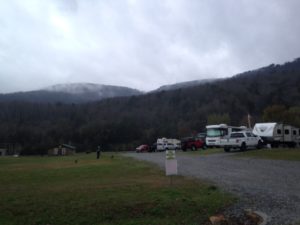 Raccoon Mountain is part of the Smokeys – it is certainly nice to be in mountains again after the monotony of the coastal plain. The RV camping part of the campground is basic, but the folks in the office are friendly and the campground is part of a larger complex than includes Raccoon Mountain caverns and several hiking trails. There are lots of birds in the bushes surrounding the campground, and we have been learning to use our binoculars and identify birds.
Raccoon Mountain is part of the Smokeys – it is certainly nice to be in mountains again after the monotony of the coastal plain. The RV camping part of the campground is basic, but the folks in the office are friendly and the campground is part of a larger complex than includes Raccoon Mountain caverns and several hiking trails. There are lots of birds in the bushes surrounding the campground, and we have been learning to use our binoculars and identify birds.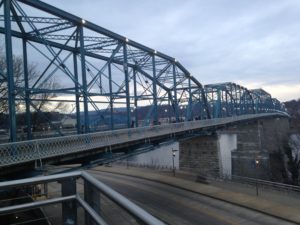 In 1890, a new bridge was built extending Walnut Street to the opposite shore. While other bridges have since been built, the Walnut Street Bridge continued to be used until 1978. For the following decade it was not used, and there were plans to tear it down. However, around 1988 it was resurrected as a historic site, and was refurbished as a pedestrian walkway.
In 1890, a new bridge was built extending Walnut Street to the opposite shore. While other bridges have since been built, the Walnut Street Bridge continued to be used until 1978. For the following decade it was not used, and there were plans to tear it down. However, around 1988 it was resurrected as a historic site, and was refurbished as a pedestrian walkway.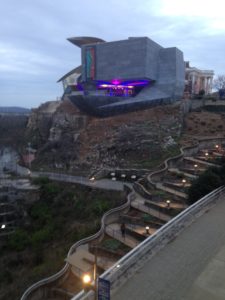
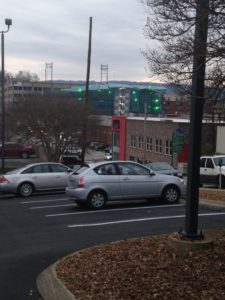 Downtown Chattanooga is small, but pretty, especially in the evening and viewed from the bridge. They have perfected the use of floodlights to enhance the scene. One very attractive floodlit building is part parking garage, part climbing wall – the building with green lights to the right. Closer to the water are the glass roofs of the Tennessee Aquarium buildings, and at the downtown end of the Walnut Street Bridge is the Hunter Museum of Modern Art, also with interesting lighting (to the left).
Downtown Chattanooga is small, but pretty, especially in the evening and viewed from the bridge. They have perfected the use of floodlights to enhance the scene. One very attractive floodlit building is part parking garage, part climbing wall – the building with green lights to the right. Closer to the water are the glass roofs of the Tennessee Aquarium buildings, and at the downtown end of the Walnut Street Bridge is the Hunter Museum of Modern Art, also with interesting lighting (to the left).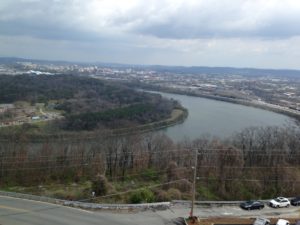 The following day we started our sightseeing on Lookout Mountain, a limestone table mountain which overlooks the city from an imposing height. On the city side, the mountainside is a sheer cliff rising from the Tennessee River Valley.
The following day we started our sightseeing on Lookout Mountain, a limestone table mountain which overlooks the city from an imposing height. On the city side, the mountainside is a sheer cliff rising from the Tennessee River Valley.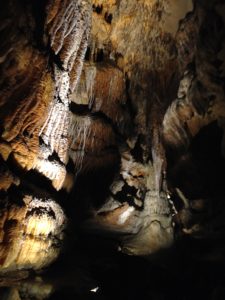
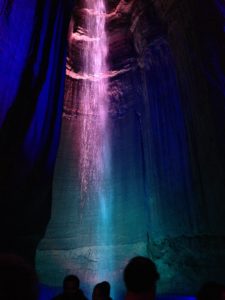 Lambert re-opened the original cavern as a tourist attraction and then blasted out enough of the new cavern to admit tourists. However, the original cavern must not be very interesting, because only the Ruby Falls cavern is now open. It is now accessed by an elevator ride deep into the mountain and a walk of almost an hour through the cave (all of it lit and most of it wide enough to walk two or three abreast and at least 65″ high. (I can vouch for the height because although Chuck occasionally had to duck, I never did.)
Lambert re-opened the original cavern as a tourist attraction and then blasted out enough of the new cavern to admit tourists. However, the original cavern must not be very interesting, because only the Ruby Falls cavern is now open. It is now accessed by an elevator ride deep into the mountain and a walk of almost an hour through the cave (all of it lit and most of it wide enough to walk two or three abreast and at least 65″ high. (I can vouch for the height because although Chuck occasionally had to duck, I never did.)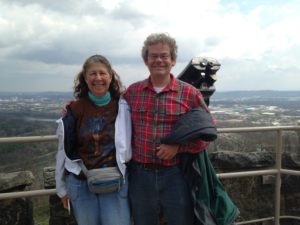 At the end of the tour, upon exiting the elevator, you can climb a tower to get a terrific view over the Tennessee River Valley and Chattanooga.
At the end of the tour, upon exiting the elevator, you can climb a tower to get a terrific view over the Tennessee River Valley and Chattanooga.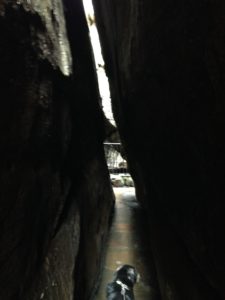
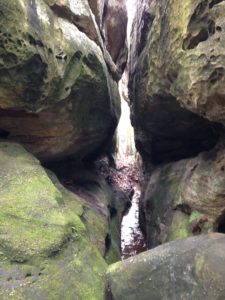 A numbered path takes you through or over the crevasses. Whenever you are on the top of the slabs, you have a spectacular view over the valley.
A numbered path takes you through or over the crevasses. Whenever you are on the top of the slabs, you have a spectacular view over the valley.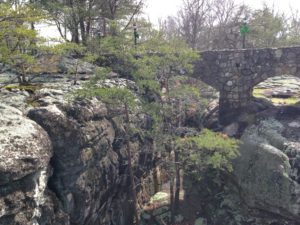
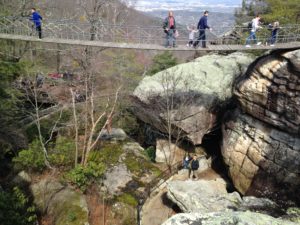 A somewhat bizarre aspect of Rock City is due to the founder’s love of German folklore. The venue is decorated with hundreds of garden gnomes, (no pictures included) which is just as weird as it sounds.
A somewhat bizarre aspect of Rock City is due to the founder’s love of German folklore. The venue is decorated with hundreds of garden gnomes, (no pictures included) which is just as weird as it sounds.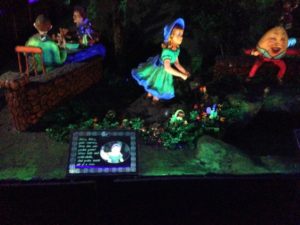 As well, one tunnel is filled with scenes from German fairy tales, all painted in glowing “black light” fluorescent color.
As well, one tunnel is filled with scenes from German fairy tales, all painted in glowing “black light” fluorescent color.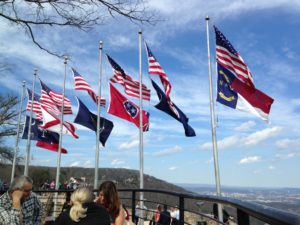
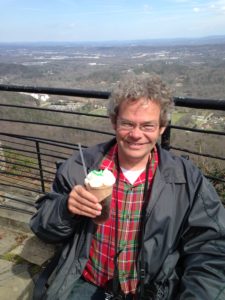
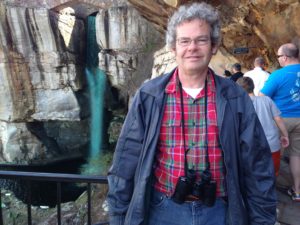
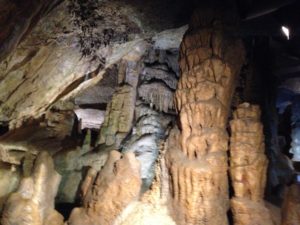 We have been to several caves in PA, including our local Penn’s Cave. The rock formations at Raccoon Mountain are far more spectacular than anything I have seen previously. As well, there are 3 species of salamander (we saw two of these), crickets, spiders and bats in the caves (although we did not see the spiders or bats).
We have been to several caves in PA, including our local Penn’s Cave. The rock formations at Raccoon Mountain are far more spectacular than anything I have seen previously. As well, there are 3 species of salamander (we saw two of these), crickets, spiders and bats in the caves (although we did not see the spiders or bats). 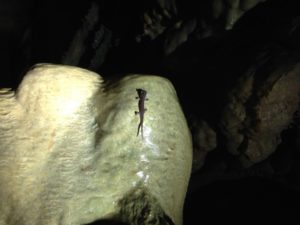
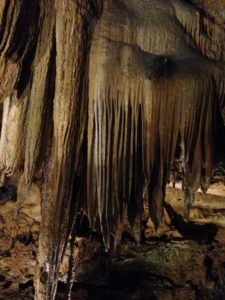 As
As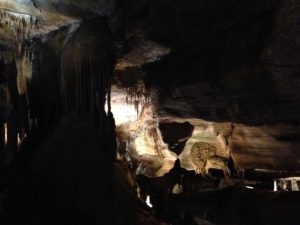
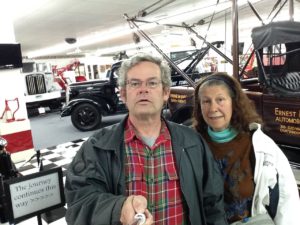 We next headed off to the “Towing and Recovery Museum” which is devoted to tow trucks. Chattanooga auto mechanic Holmes decided that it would be more efficient to bring cars to his shop for repairs, rather than to do the work roadside. He fitted out a Ford truck with a hoist, and created the first tow truck. The museum is small, but is fitted out with a number of antique tow trucks and a lot of historical notes.
We next headed off to the “Towing and Recovery Museum” which is devoted to tow trucks. Chattanooga auto mechanic Holmes decided that it would be more efficient to bring cars to his shop for repairs, rather than to do the work roadside. He fitted out a Ford truck with a hoist, and created the first tow truck. The museum is small, but is fitted out with a number of antique tow trucks and a lot of historical notes.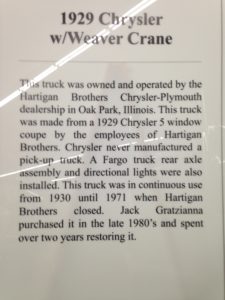 One aspect that I enjoyed was that for each truck, the details of the restoration was included.
One aspect that I enjoyed was that for each truck, the details of the restoration was included. 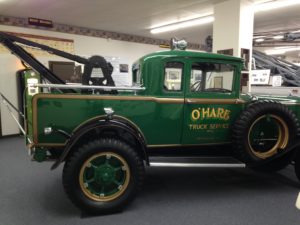
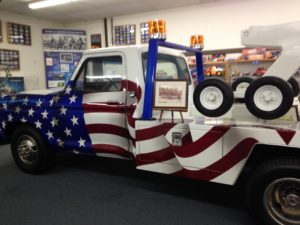
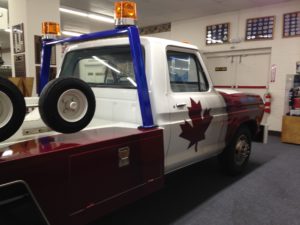 In many cases, the original truck is not on display, but rather was recreated from vintage parts. The work involved was brought to our attention a few days later in Corbin, where we saw a decaying model T sitting in a car lot.
In many cases, the original truck is not on display, but rather was recreated from vintage parts. The work involved was brought to our attention a few days later in Corbin, where we saw a decaying model T sitting in a car lot.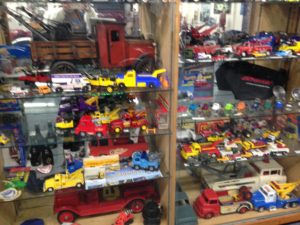
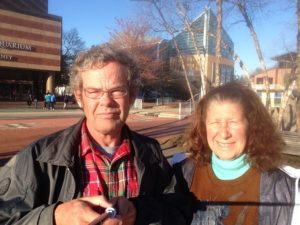 After that we had about 3 hours to see the Tennessee Aquarium in downtown Chattanooga. The Aquarium is actually housed in 3 buildings and an IMAX theatre. One building is devoted to educational displays (no live fish). One building has a huge aquarium of ocean fish, along with smaller tanks that contain other displays (such as the jelly fish tanks).
After that we had about 3 hours to see the Tennessee Aquarium in downtown Chattanooga. The Aquarium is actually housed in 3 buildings and an IMAX theatre. One building is devoted to educational displays (no live fish). One building has a huge aquarium of ocean fish, along with smaller tanks that contain other displays (such as the jelly fish tanks).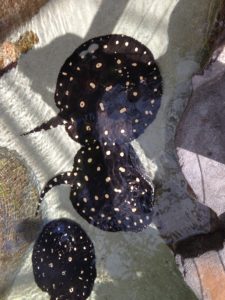
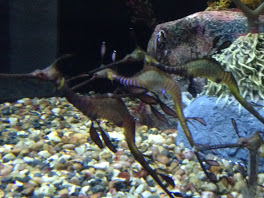
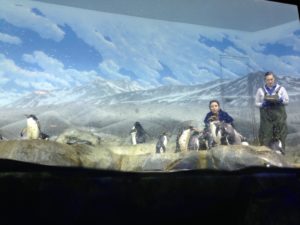 The third building is devoted to freshwater fish and has a huge aquarium representing river life. The entrance, however, is devoted to two species of penguin, which were enjoying dinner when we arrived.
The third building is devoted to freshwater fish and has a huge aquarium representing river life. The entrance, however, is devoted to two species of penguin, which were enjoying dinner when we arrived.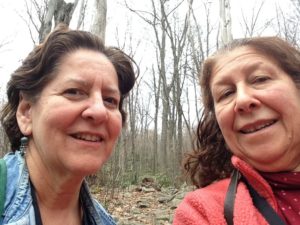 As usual, we forgot to take photos with most of our friends, but I am posting the ones we did take: Naomi and Becky on a hike at Shingletown Gap and Naomi, Chuck and Susie at Mario’s Restaurant. My apologies to everyone who we forgot to immortalize on the blog! You are nevertheless in our hearts.
As usual, we forgot to take photos with most of our friends, but I am posting the ones we did take: Naomi and Becky on a hike at Shingletown Gap and Naomi, Chuck and Susie at Mario’s Restaurant. My apologies to everyone who we forgot to immortalize on the blog! You are nevertheless in our hearts.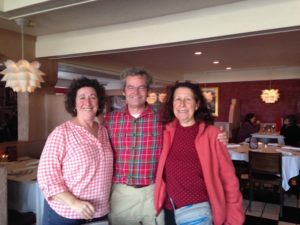 We are coming back in late April for more appointments and we hope to see anyone we missed.
We are coming back in late April for more appointments and we hope to see anyone we missed.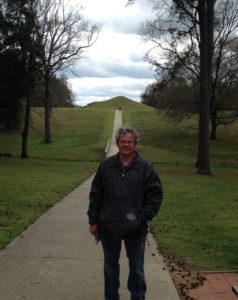 We then headed for a remarkable archeological site, the Ocmulgee National Monument. This is a set of ancient mounds. Although they are grass-covered piles of dirt, they are huge. And a map of the site is very reminiscent of the Pyramids at Mexico City, with a huge temple mound at the end of a large rectangle surrounded by smaller mounds.
We then headed for a remarkable archeological site, the Ocmulgee National Monument. This is a set of ancient mounds. Although they are grass-covered piles of dirt, they are huge. And a map of the site is very reminiscent of the Pyramids at Mexico City, with a huge temple mound at the end of a large rectangle surrounded by smaller mounds.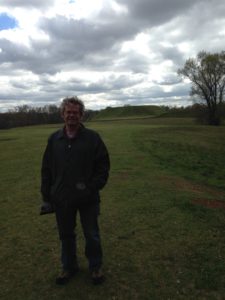
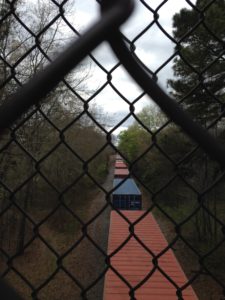 In 1843, a railroad line was constructed that cut right through the site and through several mounds. This both exposed the archeological value of the site and destroyed many artifacts, including 2 of the mounds – one of which was a burial site. The line is still used – the photo shows a container freight car going through.
In 1843, a railroad line was constructed that cut right through the site and through several mounds. This both exposed the archeological value of the site and destroyed many artifacts, including 2 of the mounds – one of which was a burial site. The line is still used – the photo shows a container freight car going through.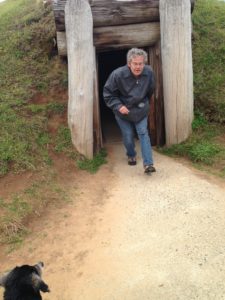 Creek Nation, which still considers the site sacred.
Creek Nation, which still considers the site sacred.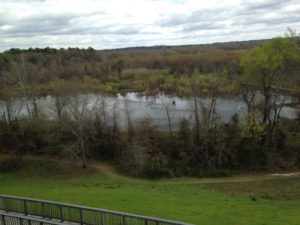 As well, the National Monument has a number of hiking trails. I was quite amazed to see signs warning that alligators are common, as this is well out of the coastal plain and into the rolling hills of western Georgia. However, with temperatures in the 40’s, we did not see any gators.
As well, the National Monument has a number of hiking trails. I was quite amazed to see signs warning that alligators are common, as this is well out of the coastal plain and into the rolling hills of western Georgia. However, with temperatures in the 40’s, we did not see any gators.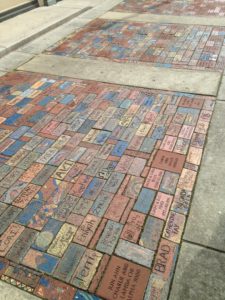
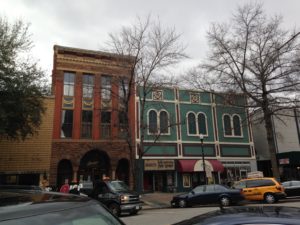
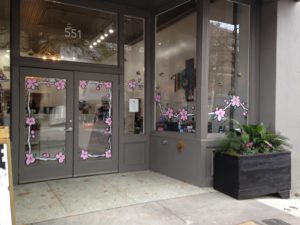 According to the website, Macon has 350,000 cherry trees. I am not sure how this compares with DC, but the annual cherry blossom festival is a very big deal here. It is coming up in 2 weeks, and already most of the downtown stores have blossoms painted on their windows and goods with blossoms (such as T-shirts and paintings) prominently displayed.
According to the website, Macon has 350,000 cherry trees. I am not sure how this compares with DC, but the annual cherry blossom festival is a very big deal here. It is coming up in 2 weeks, and already most of the downtown stores have blossoms painted on their windows and goods with blossoms (such as T-shirts and paintings) prominently displayed.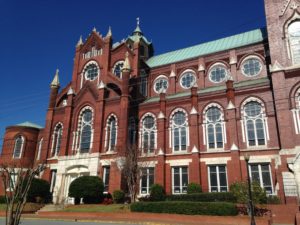 On
On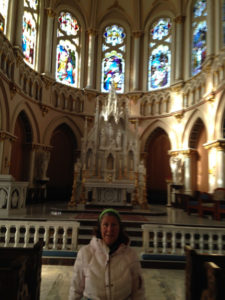
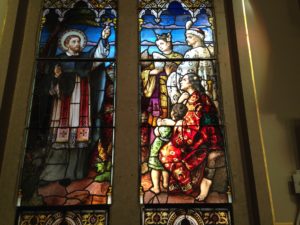 Wednesday we set out to see the rest of our priority Macon attractions. We started at the Catholic church, which rivals the cathedrals of Europe. We were very taken with the detail in the stained glass windows, which included embroidery and lace on the robes of the various saints.
Wednesday we set out to see the rest of our priority Macon attractions. We started at the Catholic church, which rivals the cathedrals of Europe. We were very taken with the detail in the stained glass windows, which included embroidery and lace on the robes of the various saints.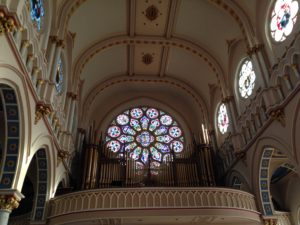
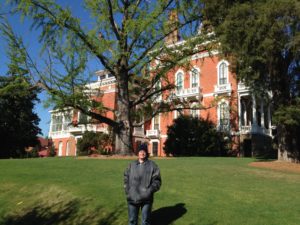
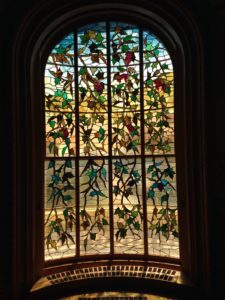
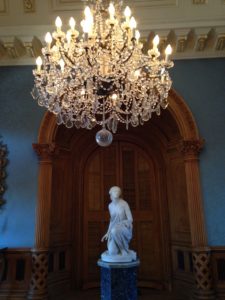
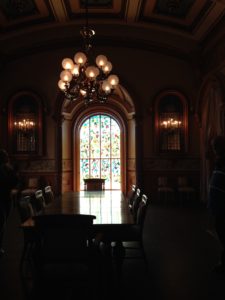 He and his much younger wife were very interested in both art and technology and spent 3 years in Europe, collecting art and ideas. The house is huge (of course) and had a large room with natural light to house their artwork. As well, the house had an advanced ventilation system, central heat, hot and cold running water, and a larder designed to keep vermin and mold at bay.
He and his much younger wife were very interested in both art and technology and spent 3 years in Europe, collecting art and ideas. The house is huge (of course) and had a large room with natural light to house their artwork. As well, the house had an advanced ventilation system, central heat, hot and cold running water, and a larder designed to keep vermin and mold at bay. 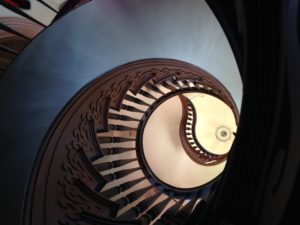 They also had beautiful wood and glass pocket doors – even in the rooms with curved walls. However, all their wealth and technology did not save them from losing their first 4 children all before the age of 2. The last 2 survived and split the estate – one retaining the house. Her offspring sold the house to the Hays. When the Hays offspring could not longer sustain the house as a museum, they gave it to the Georgia Historical Trust, which has had more success in maintaining and marketing the house.
They also had beautiful wood and glass pocket doors – even in the rooms with curved walls. However, all their wealth and technology did not save them from losing their first 4 children all before the age of 2. The last 2 survived and split the estate – one retaining the house. Her offspring sold the house to the Hays. When the Hays offspring could not longer sustain the house as a museum, they gave it to the Georgia Historical Trust, which has had more success in maintaining and marketing the house.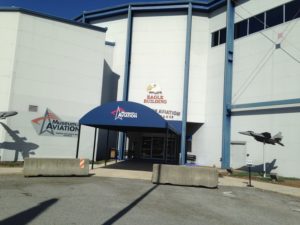 After lunch Chuck and I parted ways. Chuck here: I went to the air museum at Robbins Air Force Base, which is the second largest one in the country. They had a huge number of planes there and I could not do justice to all of them in the time I was there. The highlight for me was the SR-71 Blackbird (picture below).
After lunch Chuck and I parted ways. Chuck here: I went to the air museum at Robbins Air Force Base, which is the second largest one in the country. They had a huge number of planes there and I could not do justice to all of them in the time I was there. The highlight for me was the SR-71 Blackbird (picture below).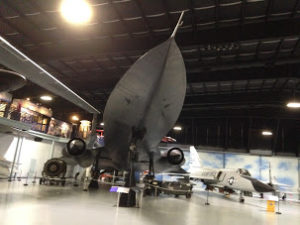
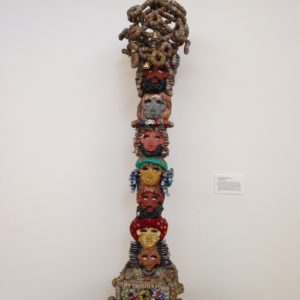 (Naomi) I went to the Tubman Museum, which is an eclectic assortment of African-American collections, including an interesting contemporary art collection, an exhibit of some of the inventions and technological advances created by African-Americans (including some types of refrigeration, an enhancement to the rotary lawn mower, a method for refining sugar, etc, but notably not the Otis safety elevator), As well there was a short film about the daring escape of a Macon slave couple. She, the daughter of her master, was very fair and passed herself off as an ailing young man accompanied by her slave (her husband) going to a hospital in Philadelphia. Due to the Fugitive Slave Act they eventually moved to England but returned to the US after the Civil War.
(Naomi) I went to the Tubman Museum, which is an eclectic assortment of African-American collections, including an interesting contemporary art collection, an exhibit of some of the inventions and technological advances created by African-Americans (including some types of refrigeration, an enhancement to the rotary lawn mower, a method for refining sugar, etc, but notably not the Otis safety elevator), As well there was a short film about the daring escape of a Macon slave couple. She, the daughter of her master, was very fair and passed herself off as an ailing young man accompanied by her slave (her husband) going to a hospital in Philadelphia. Due to the Fugitive Slave Act they eventually moved to England but returned to the US after the Civil War.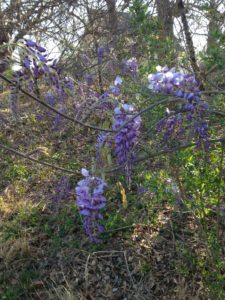
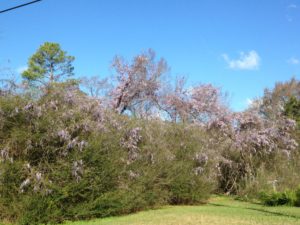 Around the park, the woods are purple with invasive wisteria. The trees are just beginning to bud out, but the wisteria is already heavy with masses of purple blooms. It is very pretty – but we saw during our sabbatical in NC how the massive vines can bring down entire stands of trees with their weight. I was a bit surprised that the park butterfly garden has an arbor covered with wisteria – at least it grows well here!
Around the park, the woods are purple with invasive wisteria. The trees are just beginning to bud out, but the wisteria is already heavy with masses of purple blooms. It is very pretty – but we saw during our sabbatical in NC how the massive vines can bring down entire stands of trees with their weight. I was a bit surprised that the park butterfly garden has an arbor covered with wisteria – at least it grows well here!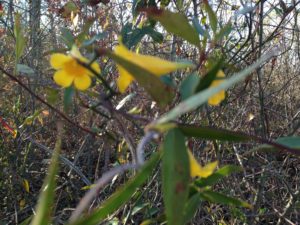
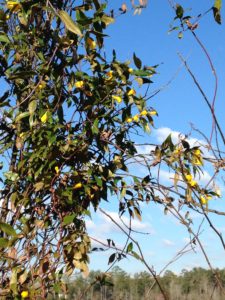 Speaking of invasive plants, another pretty invasive here is cat’s claw. Like the wisteria, it is already in bloom. It does not seem to be quite as devastating however, as the vines are thin.
Speaking of invasive plants, another pretty invasive here is cat’s claw. Like the wisteria, it is already in bloom. It does not seem to be quite as devastating however, as the vines are thin.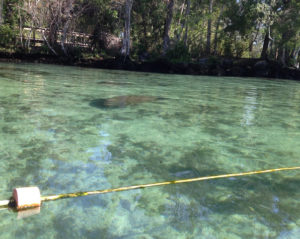 Manatees are large (1/2 ton) herbivorous aquatic mammals. They do not have blubber, so keeping up their internal temperature during a cold snap is difficult. The Crystal River estuary has a number of natural springs which emerge at 72F all year. The manatees use these like a hot tub, and hang out there when their feeding grounds in the Gulf of Mexico are too cold. They eat sea grass, which grows in the shallow waters of the coast and looks like the cellophane “grass” in Easter baskets. It does not grow in the area of the springs, but does grow in the brackish water of the river mouth nearby.
Manatees are large (1/2 ton) herbivorous aquatic mammals. They do not have blubber, so keeping up their internal temperature during a cold snap is difficult. The Crystal River estuary has a number of natural springs which emerge at 72F all year. The manatees use these like a hot tub, and hang out there when their feeding grounds in the Gulf of Mexico are too cold. They eat sea grass, which grows in the shallow waters of the coast and looks like the cellophane “grass” in Easter baskets. It does not grow in the area of the springs, but does grow in the brackish water of the river mouth nearby.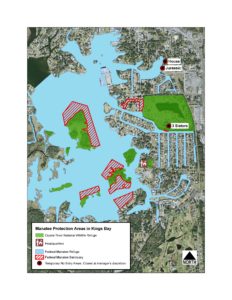 The Crystal River estuary is not exactly what you think of when you think of a nature preserve for large mammals. The map shows Kings Bay. All of the red areas are parts of the reserve. The many straight waterways are canals cut into the residential districts so that people can dock their boats in their backyards. All of these are lined with nice houses, each with a dock and most with a reasonably large boat. These predate the preserve, which was not established until 1983. The red areas are the preserve, where humans are not allowed during manatee season. The manatee above is in a reserve area marked off with buoys. Boats are allowed throughout the Bay, but only at idle speed. Apparently propellers do not kill manatees, but high speed impacts do.
The Crystal River estuary is not exactly what you think of when you think of a nature preserve for large mammals. The map shows Kings Bay. All of the red areas are parts of the reserve. The many straight waterways are canals cut into the residential districts so that people can dock their boats in their backyards. All of these are lined with nice houses, each with a dock and most with a reasonably large boat. These predate the preserve, which was not established until 1983. The red areas are the preserve, where humans are not allowed during manatee season. The manatee above is in a reserve area marked off with buoys. Boats are allowed throughout the Bay, but only at idle speed. Apparently propellers do not kill manatees, but high speed impacts do.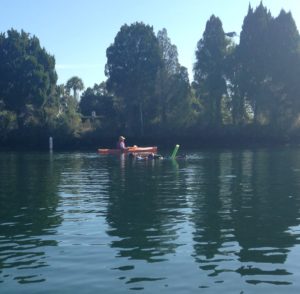 The most peculiar part of the reserve is the little crescent beside the big green area. This is a spring-fed canal which is lined with big homes and big boats. However, no-one, including the home owners, is allowed on the water during manatee season. I cannot imagine what political finangling went into making this happen. However, most of the manatees we saw from our kayak were swimming into or out of this area. Here we are at the mouth of the reserve, along with a swimming tour group in the water with a noodle for floatation and hovering over a manatee. Swimmers are required to stay at the surface, and all the touring companies ensure this by requiring everyone to swim with a noodle.
The most peculiar part of the reserve is the little crescent beside the big green area. This is a spring-fed canal which is lined with big homes and big boats. However, no-one, including the home owners, is allowed on the water during manatee season. I cannot imagine what political finangling went into making this happen. However, most of the manatees we saw from our kayak were swimming into or out of this area. Here we are at the mouth of the reserve, along with a swimming tour group in the water with a noodle for floatation and hovering over a manatee. Swimmers are required to stay at the surface, and all the touring companies ensure this by requiring everyone to swim with a noodle.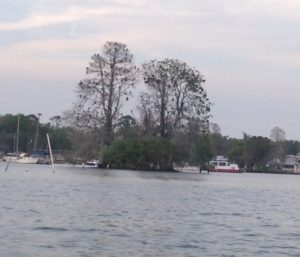
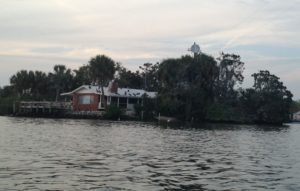 Our first evening in Crystal River we launched in the bay just north of the 3 Sisters. It was a lovely kayak trip, but we had a long paddle against the wind to the spring. We saw lots of big birds including brown and white pelicans but only a couple of manatees visible in the crescent. These two trees and this house on the water appeared to be favorite brown pelican roosting sites. The white pelicans prefer the buoys in the bay.
Our first evening in Crystal River we launched in the bay just north of the 3 Sisters. It was a lovely kayak trip, but we had a long paddle against the wind to the spring. We saw lots of big birds including brown and white pelicans but only a couple of manatees visible in the crescent. These two trees and this house on the water appeared to be favorite brown pelican roosting sites. The white pelicans prefer the buoys in the bay.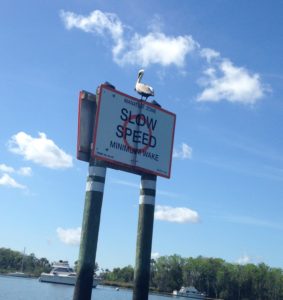
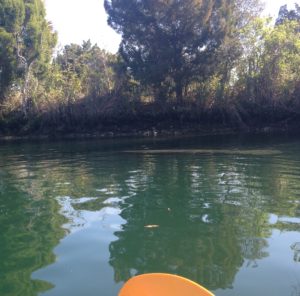 The next day we set out at 8 a.m. and launched from Pete’s Pier, which is much closer to 3 Sisters. Although manatees like to be warm, they do not like to swim against the tide, which was going out. Hence, there were very few manatees in the spring. After paddling out to the feeding areas and seeing nothing there, we paddled back to the channel
The next day we set out at 8 a.m. and launched from Pete’s Pier, which is much closer to 3 Sisters. Although manatees like to be warm, they do not like to swim against the tide, which was going out. Hence, there were very few manatees in the spring. After paddling out to the feeding areas and seeing nothing there, we paddled back to the channel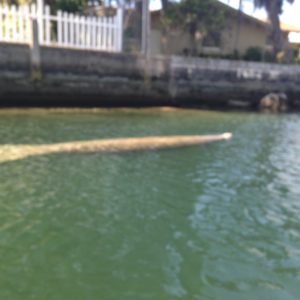 between the bay and the spring, and spotted quite a few manatees traversing the channel in small groups.
between the bay and the spring, and spotted quite a few manatees traversing the channel in small groups.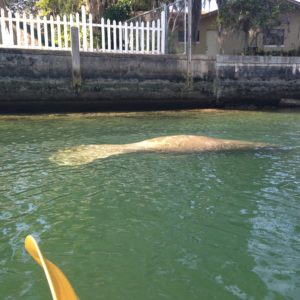
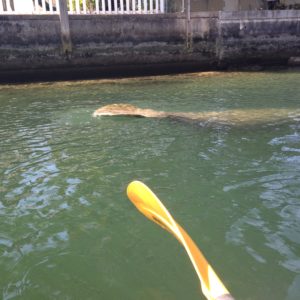 Notice that we (and the manatee) are in the canal that leads from King’s Bay to Three Sisters Spring and is completely lined with houses.
Notice that we (and the manatee) are in the canal that leads from King’s Bay to Three Sisters Spring and is completely lined with houses.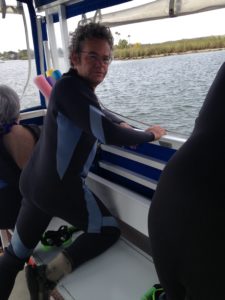
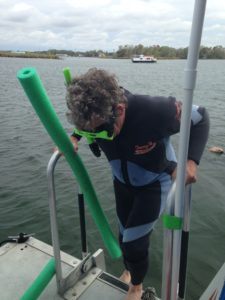
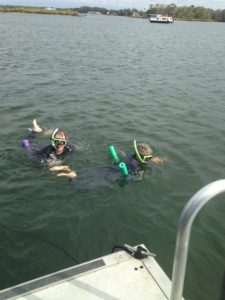 There were 10 of us, which is quite a crowd for the manatees (although it was much smaller than other groups we saw). Needless to say, there are rules for this – no diving, no putting feet down, no getting too close, no touching unless the manatee approaches you.
There were 10 of us, which is quite a crowd for the manatees (although it was much smaller than other groups we saw). Needless to say, there are rules for this – no diving, no putting feet down, no getting too close, no touching unless the manatee approaches you.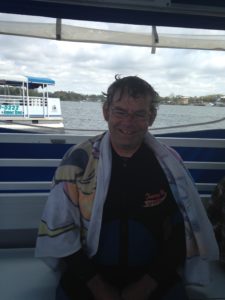 All in all, it was an exciting experience. The manatees did not see to mind – at least they hung around where we were swimming (and they can move away quickly when they want to). We were in the water for just over an hour – and even with the wet suits we were freezing by the time we got out.
All in all, it was an exciting experience. The manatees did not see to mind – at least they hung around where we were swimming (and they can move away quickly when they want to). We were in the water for just over an hour – and even with the wet suits we were freezing by the time we got out.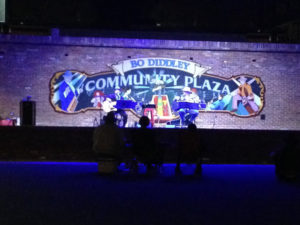 We spent the most time with our friend Anne who we knew for many years at Cornell. We always remember Anne as being outstandingly hospitable, and she continues in this mode. On Friday night we met her for dinner in downtown Gainesville (which I had never seen despite 2 previous visits to U Florida) after which we proceeded to Bo Diddley Square for a free outside concert. Since it was quite chilly, the crowd was a bit underwhelming, but we enjoyed the music.
We spent the most time with our friend Anne who we knew for many years at Cornell. We always remember Anne as being outstandingly hospitable, and she continues in this mode. On Friday night we met her for dinner in downtown Gainesville (which I had never seen despite 2 previous visits to U Florida) after which we proceeded to Bo Diddley Square for a free outside concert. Since it was quite chilly, the crowd was a bit underwhelming, but we enjoyed the music.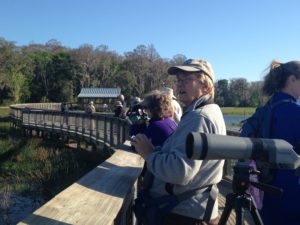 On Saturday morning, we joined Anne and her church group for bird walk in Sweetwater Wetlands Park. This area was reclaimed as a man-made wetlands to absorb nitrogen and release cleaner water to the Paynes Prairie State Park. It has become a major bird sanctuary.
On Saturday morning, we joined Anne and her church group for bird walk in Sweetwater Wetlands Park. This area was reclaimed as a man-made wetlands to absorb nitrogen and release cleaner water to the Paynes Prairie State Park. It has become a major bird sanctuary. 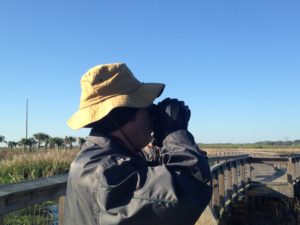 Armed with the best binoculars I have ever had the pleasure to use,(Anne’s spare pair) , Anne’s birding expertise and a small group of friendly folks, we headed off to see the most amazing collection of birds I have seen in the wild including (and I am not a birder, so this is not a full list): great blue herons, tricolored herons,
Armed with the best binoculars I have ever had the pleasure to use,(Anne’s spare pair) , Anne’s birding expertise and a small group of friendly folks, we headed off to see the most amazing collection of birds I have seen in the wild including (and I am not a birder, so this is not a full list): great blue herons, tricolored herons,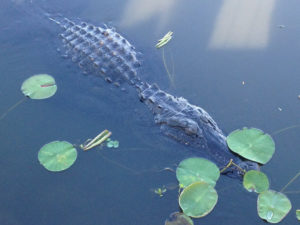 lesser blue herons, green herons, great egrets, lesser egrets, white ibis, glossy ibis, cormorants, anhingas, wood storks, bald eagle (2), ospreys, Sandhill cranes, a whooping crane (1), grackles, red-winged blackbirds, several species of swallows and of vultures.
lesser blue herons, green herons, great egrets, lesser egrets, white ibis, glossy ibis, cormorants, anhingas, wood storks, bald eagle (2), ospreys, Sandhill cranes, a whooping crane (1), grackles, red-winged blackbirds, several species of swallows and of vultures.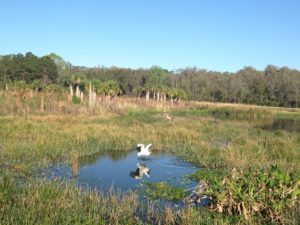 This large bird is a wood stork. I love this picture because you can see the distinctive black markings on the open wings from below as well as the view of the bird wading. There is also a great egret in the background.
This large bird is a wood stork. I love this picture because you can see the distinctive black markings on the open wings from below as well as the view of the bird wading. There is also a great egret in the background.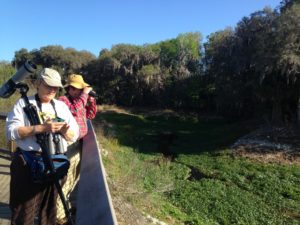
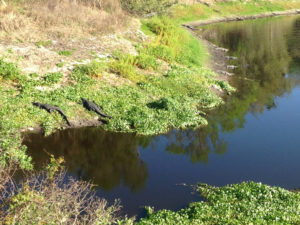 It is hard to believe that this habitat is rich enough to support this huge biomass of top predators. In this photo there are at least 8 large gators visible. This particular spot had at least 30 in the water or basking on the shore.
It is hard to believe that this habitat is rich enough to support this huge biomass of top predators. In this photo there are at least 8 large gators visible. This particular spot had at least 30 in the water or basking on the shore.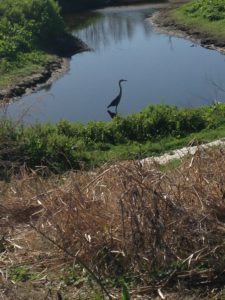
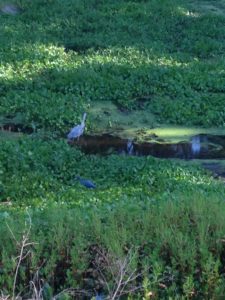
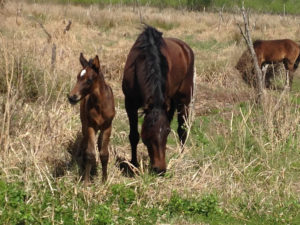
 After lunch we went to Alice Lake on the UFL campus, where I had seen alligators on previous visits. This lovely building is a chapel. A wedding was taking place.
After lunch we went to Alice Lake on the UFL campus, where I had seen alligators on previous visits. This lovely building is a chapel. A wedding was taking place.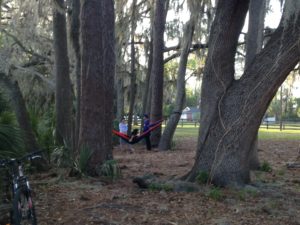
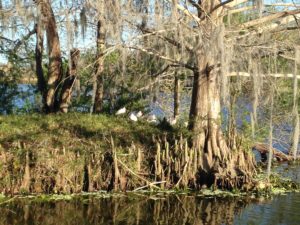 There was minimal gator activity on this trip, but huge numbers of big birds – principally greater egrets, great blue herons and anhingas, as well as the ibis in this picture – many of which were closer to the viewing area than at Sweetwater (although sadly I had returned the binoculars to Anne).
There was minimal gator activity on this trip, but huge numbers of big birds – principally greater egrets, great blue herons and anhingas, as well as the ibis in this picture – many of which were closer to the viewing area than at Sweetwater (although sadly I had returned the binoculars to Anne). 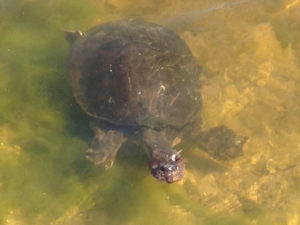 The lake aslo has many of these big turtles swimming close to shore. We wandered around the lake until dinner time at Anne’s, along with Cornell friends Jim and Maria.
The lake aslo has many of these big turtles swimming close to shore. We wandered around the lake until dinner time at Anne’s, along with Cornell friends Jim and Maria. On Sunday afternoon we went to Kanapaha Botanical Gardens with Deb. This is a lovely garden – particularly the plantings of many types of bamboo.
On Sunday afternoon we went to Kanapaha Botanical Gardens with Deb. This is a lovely garden – particularly the plantings of many types of bamboo. 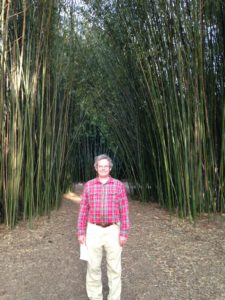
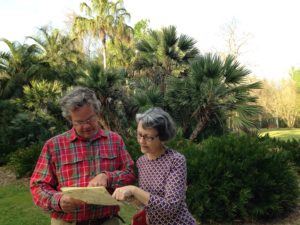
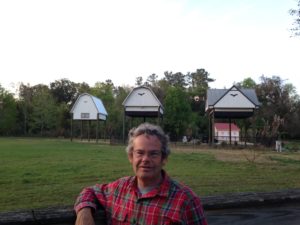 In the evening we returned to campus to watch the flight of the bats from the campus bat houses. There are about 250,000 bats in the houses. They eat about 2.5 billion insects nightly which is about 2500 pounds of insects. We’ve got to say that our walk around Alice Lake during the day was pleasantly insect-free. Just before dusk, however, the air was buzzing with bugs.
In the evening we returned to campus to watch the flight of the bats from the campus bat houses. There are about 250,000 bats in the houses. They eat about 2.5 billion insects nightly which is about 2500 pounds of insects. We’ve got to say that our walk around Alice Lake during the day was pleasantly insect-free. Just before dusk, however, the air was buzzing with bugs.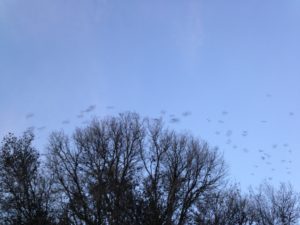 We are pretty sure that we saw at most a few thousand bats, but it was still an incredible sight, with a stream of bats emerging for about 30 minutes from 2 of the 3 houses in irregular bursts, on a path that brought them swooping over around a tree and over the lake. An enterprising red-shouldered hawk was waiting by the houses and clearly thought he was at a snack table. He grabbed one bat as it launched from the bat house and took it to a nearby tree to eat. He then sat in the stream of bats until he identified another victim which was also devoured in the tree.
We are pretty sure that we saw at most a few thousand bats, but it was still an incredible sight, with a stream of bats emerging for about 30 minutes from 2 of the 3 houses in irregular bursts, on a path that brought them swooping over around a tree and over the lake. An enterprising red-shouldered hawk was waiting by the houses and clearly thought he was at a snack table. He grabbed one bat as it launched from the bat house and took it to a nearby tree to eat. He then sat in the stream of bats until he identified another victim which was also devoured in the tree.